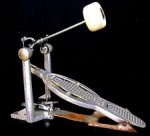Bo Eder
Platinum Member
So I have to say, every time I see a vintage Ludwig Speed King, unless it was refurbished or near mint condition, they all seem to suffer from this kind of rusting on that heel-connect piece that runs along the bottom.
Did all Ludwig players back in the day set-up in standing water? Really, I don't understand how this rust can occur. Every time I see player with newer pedals, rust is super-rare. What were these vintage drum guys doing to cause this much rust? Just wonderin' out loud.
Did all Ludwig players back in the day set-up in standing water? Really, I don't understand how this rust can occur. Every time I see player with newer pedals, rust is super-rare. What were these vintage drum guys doing to cause this much rust? Just wonderin' out loud.


